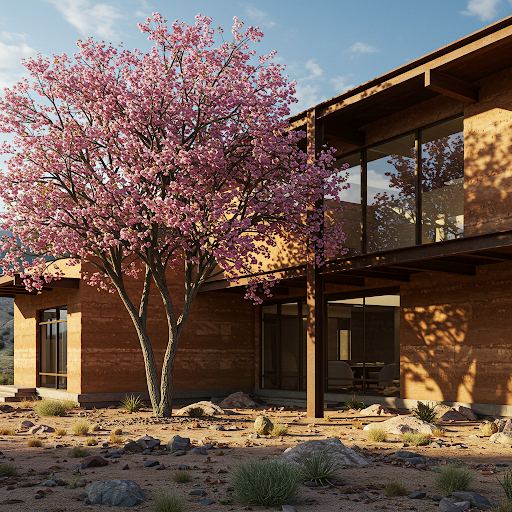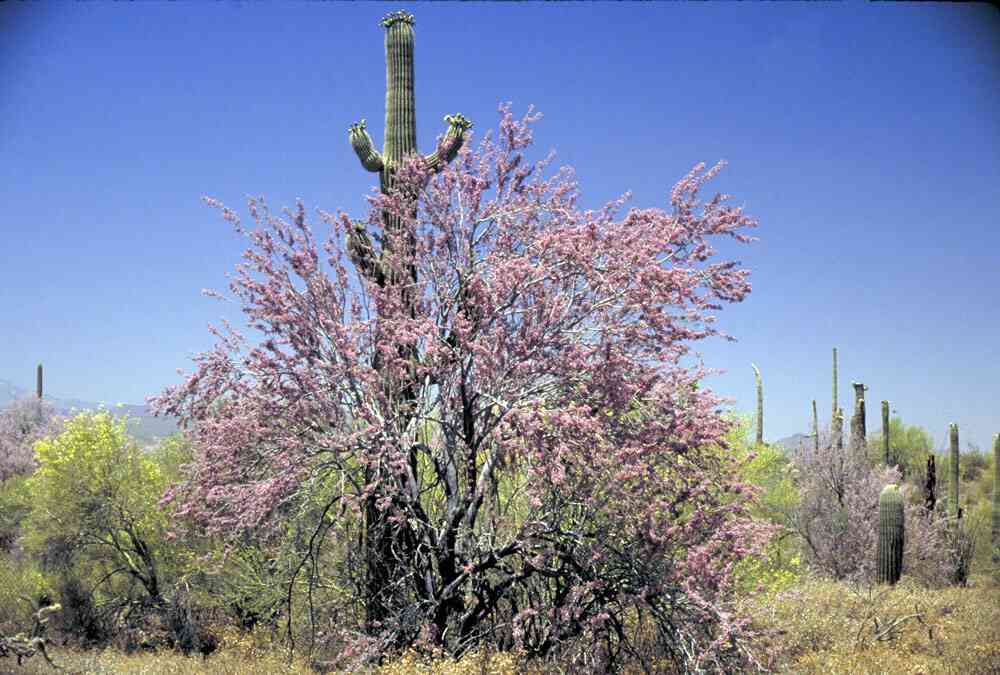The ironwood tree, with its dense, durable wood and broad canopy, is a keystone species in the Sonoran Desert. Its adaptations for longevity, shade creation, and soil enrichment offer valuable insights for creating sustainable and comfortable desert homes.
1. Durable Wood and Robust Structures:
- The ironwood's exceptionally dense and durable wood provides structural strength and longevity.
- Architectural Application:
- We can design homes with robust structural elements that mimic the ironwood's strength. Use durable, locally sourced materials, such as rammed earth, adobe, or steel, for structural walls and supports.
- Incorporate exposed structural elements, such as beams and columns, that celebrate the strength and beauty of the materials.
- Design homes with long lifespans, minimizing the need for frequent renovations or replacements.
- Example:
- A home could feature exposed steel beams and columns, creating a strong, industrial aesthetic. Rammed earth walls could provide thermal mass and structural support. The home could be designed with a long lifespan in mind, using durable materials and timeless design principles.

2. Broad Canopy and Shaded Microclimates:
- The ironwood's broad, dense canopy provides ample shade, creating cool microclimates beneath its branches.
- Architectural Application:
- We can design homes with large, cantilevered roofs or overhangs that mimic the ironwood's canopy, providing shade and reducing solar heat gain.
- Incorporate courtyards and patios with strategically placed trees or shading structures, creating cool outdoor spaces.
- Design landscapes with layered vegetation, including trees, shrubs, and groundcover, to create diverse microclimates.
- Example:
- A home could feature a large, cantilevered roof that provides shade for a patio and outdoor living area. A central courtyard with strategically placed ironwood trees could create a cool, shaded retreat. Layered landscaping with native desert plants could create diverse microclimates around the home.

3. Soil Enrichment and Ecological Design:
- The ironwood's nitrogen-fixing roots enrich the soil, creating fertile conditions for other plants.
- Architectural Application:
- We can design homes with integrated composting systems and rainwater harvesting systems, enriching the soil and promoting plant growth.
- Incorporate green roofs and living walls that support a diverse range of plant life.
- Design landscapes with native desert plants that enhance soil health and biodiversity.
- Example:
- A home could feature a composting system that enriches the soil for a vegetable garden. A rainwater harvesting system could provide water for irrigation. A green roof planted with native desert grasses and wildflowers could support a diverse range of plant life.
4. Longevity and Sustainable Practices:
- The ironwood's long lifespan reflects its resilience and adaptability to the desert environment.
- Architectural Application:
- We can design homes with sustainable building practices that minimize environmental impact and promote longevity.
- Use locally sourced and recycled materials whenever possible.
- Design for passive heating and cooling, minimizing reliance on mechanical systems.
- Incorporate renewable energy systems, such as solar panels and wind turbines.
- Example:
- A home could be constructed from locally sourced adobe bricks and recycled steel. Passive solar design strategies could minimize the need for air conditioning. Solar panels and a wind turbine could provide renewable energy.

5. Habitat Creation and Biodiversity:
- The ironwood provides habitat for a wide range of desert animals, including birds, insects, and mammals.
- Architectural Application:
- We can design homes with features that attract and support wildlife, such as bird feeders, water features, and shelter areas.
- Incorporate native desert plants into the landscape, providing food and habitat for local animals.
- Design green roofs and living walls that create habitats for pollinators and other beneficial insects.
- Example:
- A home could feature bird feeders and water features that attract a variety of desert birds. Native desert plants, such as milkweed and agave, could provide food and habitat for local animals. A green roof planted with wildflowers could attract pollinators.

Conclusion:
By studying the ironwood tree, we can design desert homes that are not only comfortable but also durable, sustainable, and ecologically sound. Its adaptations for structural strength, shade creation, soil enrichment, longevity, and habitat creation offer valuable lessons for creating dwellings that thrive in the arid landscape. By embracing biomimicry, we can build homes that are both functional and beautiful, reflecting the wisdom of the desert ecosystem and creating harmonious living spaces.




Leave a Comment